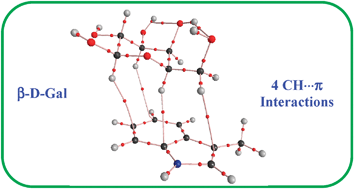Quantification of binding affinities of essential sugars with a tryptophan analogue and the ubiquitous role of C–H⋯π interactions†
Abstract
The role of noncovalent interactions in

* Corresponding authors
a
Department of Biosciences and Bioengineering, Indian Institute of Technology Bombay, Powai, Mumbai 400076, India
E-mail:
balaji@iitb.ac.in
b
Department of Chemistry, Indian Institute of Technology Bombay, Powai, Mumbai 400076, India
E-mail:
sunoj@chem.iitb.ac.in
The role of noncovalent interactions in

 Please wait while we load your content...
Something went wrong. Try again?
Please wait while we load your content...
Something went wrong. Try again?
M. Kumari, P. V. Balaji and R. B. Sunoj, Phys. Chem. Chem. Phys., 2011, 13, 6517 DOI: 10.1039/C0CP02559C
To request permission to reproduce material from this article, please go to the Copyright Clearance Center request page.
If you are an author contributing to an RSC publication, you do not need to request permission provided correct acknowledgement is given.
If you are the author of this article, you do not need to request permission to reproduce figures and diagrams provided correct acknowledgement is given. If you want to reproduce the whole article in a third-party publication (excluding your thesis/dissertation for which permission is not required) please go to the Copyright Clearance Center request page.
Read more about how to correctly acknowledge RSC content.
 Fetching data from CrossRef.
Fetching data from CrossRef.
This may take some time to load.
Loading related content
